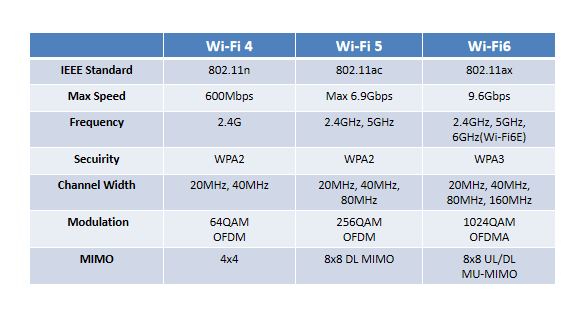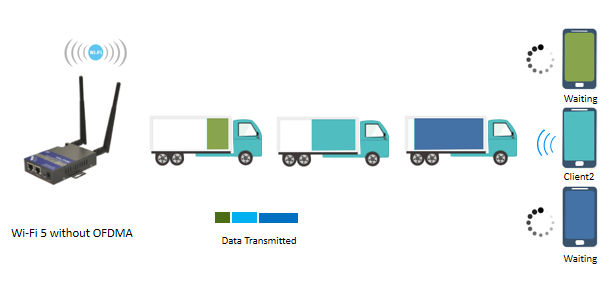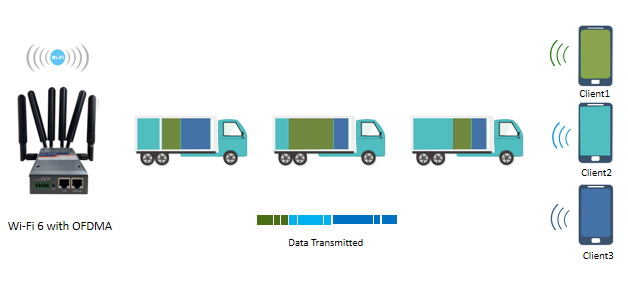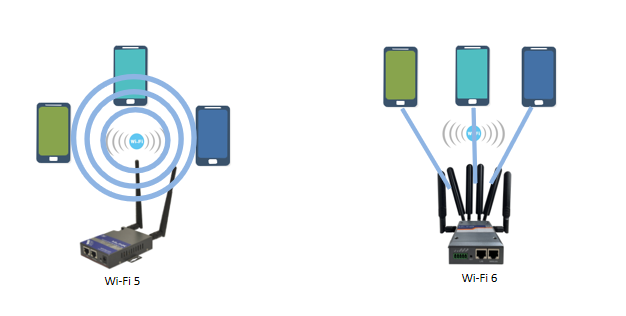
HOME < Technology < Wi-Fi 6 Introduction
1. What is Wi-Fi 6
The IEEE 802.11ax, also known as Wi-Fi 6, is an IEEE standard for wireless local-area networks (WLANs) and the successor of 802.11ac. It is also known as High Efficiency Wi-Fi, for the overall improvements to Wi-Fi 6 clients under dense environments. It is designed to operate in license-exempt bands between 1 GHz and 7.125 GHz, including the 2.4 GHz and 5 GHz bands already in common use as well as the much wider 6 GHz band called Wi-Fi 6E.
2. Wi-Fi 6 Key Features

The key feature of 802.11ax is orthogonal frequency-division multiple access (OFDMA), which is equivalent to cellular technology applied into Wi-Fi. Other improvements on spectrum utilization are better power-control methods to avoid interference with neighboring networks, higher order 1024 QAM, up-link direction added with the down-link of MIMO and MU-MIMO to further increase throughput, as well as dependability improvements of power consumption and security protocols such as Target Wake Time and WPA3.
Orthogonal Frequency Division Multiple Access (OFDMA)
OFDMA segregates the spectrum in time-frequency resource units, which works by subdividing channels into subcarriers and allowing for transmission to multiple endpoints (devices) at the same time. A Wi-Fi 6 router can send different signals in the same transmission window. This results in a single transmission from the router being able to communicate with multiple devices, instead of each device having to wait its turn as the router serves up the data across the network. OFDMA-based scheduling reduces overhead and latency.


Multi-user MIMO (MU-MIMO)
With downlink MU-MIMO an AP may transmit concurrently to multiple stations and with uplink MU-MIMO an AP may simultaneously receive from multiple stations. Whereas OFDMA separates receivers to different RUs, with MU-MIMO the devices are separated to different spatial streams.
Overlapping Basic Service Sets (OBSS)
Overlapping Basic Service Sets (OBSS) is another Wi-Fi 6 feature that can help to improve network congestion. OBSS enables the access point to use a ‘color’ in order to uniquely identify the network. Coloring enables devices to differentiate transmissions in their own network from transmissions in neighboring networks. Adaptive power and sensitivity thresholds allow dynamically adjusting transmit power and signal detection threshold to increase spatial reuse.
Beamforming
Beamforming is another technology that Wi-Fi 6 improves in order to achieve higher speeds. This futuristic-sounding data transmission method is actually relatively simple. Instead of broadcasting data in all directions, the router detects where the device requesting the data is located and transmits a more localized data stream in that direction.

Target Wake Time (TWT)
TWT is a concept developed in 802.11ah, which reduces power consumption and medium access contention. It allows devices to wake up at other periods than the beacon transmission period. Furthermore, the AP may group device to different TWT period thereby reducing the number of devices contending simultaneously for the wireless medium.
WPA3
WPA3 is requested for Wi-Fi6 by Wi-Fi Alliance. One of the biggest improvements is the implementation of increased password security via the Dragonfly Key Exchange system, also called SAE or Simultaneous Authentication of Equals. This authentication method helps make passwords harder to crack by using a more sophisticated method of establishing the handshake with the Wi-Fi network. This added layer of security, coupled with stronger encryption, means Wi-Fi will have more robust security options than ever.
3. Wi-Fi 6 Advantage
Increased access point capacity
Wi-Fi 6 uses the implementation of a technology called Orthogonal Frequency Division Multiple Access. This technology can classify one wireless channel into several sub-channels and each of these sub-channels have the ability to carry data for different devices. It makes Wi-Fi 6 better suited to handle modern IoT and workplace access demands.
Faster Speed
The theoretical speed of Wi-Fi 6 is 9.6Gbps. It achieves this speed increase by combining the 2.4GHx and 5GHz spectrum bands and employing MU-MIMO technology for both uplink and downlink data transfers.
More efficient data encoding leads to the higher throughput. A single device can achieve up to 40% faster data transfer when using Wi-Fi 6 versus Wi-Fi 5. Even 2.4GHz networks will experience increased speeds when using a Wi-Fi 6 router.
Greater channel width
5GHz channels allow you to aggregate 20MHz channels into 40MHz and 80MHz channels, giving you higher speeds. With Wi-Fi 6, it will even be able to reach 160MHz channels.
Wi-Fi sleeping
Wi-Fi 6 has protocols to effectively put certain device’s Wi-Fi to “sleep” when it’s not being used. This frees up bandwidth by “sleeping” connections that aren’t in use. Further, Battery life is extended through a feature known as target wake time (TWT). TWT enables the Wi-Fi access point to communicate with your device to tell it when exactly to turn its Wi-Fi radio to wake up and go to sleep. This helps conserve power.











